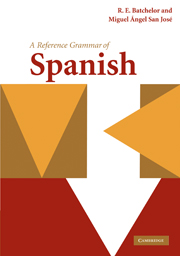Book contents
- Frontmatter
- Contents
- Preface/Prólogo
- Acknowledgments/Agradecimientos
- Abbreviations/Abreviaturas
- Introduction to the Spanish language/Introducción a la lengua española
- Part I
- 1 Register/Registro
- 2 Alphabet, spelling, pronunciation/Alfabeto, ortografía, pronunciación
- 3 Stress and accent marks/Acento tónico y acento ortográfico
- 4 Punctuation, upper case, lower case/Puntuación, mayúsculas, minúsculas
- 5 Apocopation/Apócope
- 6 Agreement/Concordancia
- Part II
- Part III
- Part IV
- Part V
- Part VI
- Part VII
- Part VIII
- Part IX
- Part X
- Appendix I Verb tables/ Tablas de verbos
- Appendix II Glossary/Glosario
- Bibliography/Bibliografía
- General index/Índice general
- Subjunctive index/Índice del subjuntivo
3 - Stress and accent marks/Acento tónico y acento ortográfico
from Part I
Published online by Cambridge University Press: 05 June 2012
- Frontmatter
- Contents
- Preface/Prólogo
- Acknowledgments/Agradecimientos
- Abbreviations/Abreviaturas
- Introduction to the Spanish language/Introducción a la lengua española
- Part I
- 1 Register/Registro
- 2 Alphabet, spelling, pronunciation/Alfabeto, ortografía, pronunciación
- 3 Stress and accent marks/Acento tónico y acento ortográfico
- 4 Punctuation, upper case, lower case/Puntuación, mayúsculas, minúsculas
- 5 Apocopation/Apócope
- 6 Agreement/Concordancia
- Part II
- Part III
- Part IV
- Part V
- Part VI
- Part VII
- Part VIII
- Part IX
- Part X
- Appendix I Verb tables/ Tablas de verbos
- Appendix II Glossary/Glosario
- Bibliography/Bibliografía
- General index/Índice general
- Subjunctive index/Índice del subjuntivo
Summary
In Spanish, as in English, in words of two or more syllables, one is pronounced more forcibly than the others. This forcible utterance is called stress. In writing, it appears thus: á, é, í, ó, ó. As it would be laborious, unnecessary and even confusing to place an accent mark over every written word, words are grouped into classes. Words coming into these classes do not need the written accent; only the exceptions require it. Here are the basic rules governing the use of stress and the written accent.
The greater part of words ending in a vowel are stressed (but not in writing) on the penultimate (next to last) syllable: pero (but), perro (dog), lleva (he/she takes), carro (M)/coche (car), casa (house), bomba (bomb/pump), libro (book).
The greater part of words ending in n or s are stressed (but not in writing) on the penultimate syllable: toman (they take, you take), margen (margin/edge), imagen (image/picture), volumen, martes (Tuesday), crisis.
The greater part of words ending in consonants other than n or s are stressed (but not in writing) on the last syllable: esperar (to hope/wait for), decir (to say), (all infinitives), alfiler (pin), peral (pear tree), perejil (parsley; and, extraordinarily, the name of a very small island, Persil, a Spanish possession a few hundred yards off the Moroccan coast that gave rise to a diplomatic incident in July 2002), altivez (haughtiness), majestad (majesty), magnitud.
- Type
- Chapter
- Information
- A Reference Grammar of Spanish , pp. 26 - 29Publisher: Cambridge University PressPrint publication year: 2010



